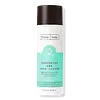What's inside
What's inside
 Key Ingredients
Key Ingredients

 Benefits
Benefits

 Concerns
Concerns

 Ingredients Side-by-side
Ingredients Side-by-side

Water
Skin ConditioningCaprylic/Capric Triglyceride
MaskingLactic Acid
BufferingGlyceryl Stearate
EmollientGlycerin
HumectantCetearyl Alcohol
EmollientCetearyl Stearate
Skin ConditioningEugenol
PerfumingMacadamia Integrifolia Seed Oil
Skin ConditioningEremophila Longifolia Leaf Extract
AntioxidantMaclura Cochinchinensis Leaf Extract
Skin ConditioningSantalum Acuminatum Fruit Extract
AntioxidantTerminalia Ferdinandiana Fruit Extract
AntioxidantMangifera Indica Seed Butter
Skin ConditioningVitis Vinifera Seed Oil
EmollientPotassium Cetyl Phosphate
EmulsifyingQuartz
AbrasiveParfum
MaskingMagnesium Aluminum Silicate
AbsorbentXanthan Gum
EmulsifyingGlycolic Acid
BufferingSodium Hydroxide
BufferingMalic Acid
BufferingWater, Caprylic/Capric Triglyceride, Lactic Acid, Glyceryl Stearate, Glycerin, Cetearyl Alcohol, Cetearyl Stearate, Eugenol, Macadamia Integrifolia Seed Oil, Eremophila Longifolia Leaf Extract, Maclura Cochinchinensis Leaf Extract, Santalum Acuminatum Fruit Extract, Terminalia Ferdinandiana Fruit Extract, Mangifera Indica Seed Butter, Vitis Vinifera Seed Oil, Potassium Cetyl Phosphate, Quartz, Parfum, Magnesium Aluminum Silicate, Xanthan Gum, Glycolic Acid, Sodium Hydroxide, Malic Acid
Water
Skin ConditioningNiacinamide
SmoothingPropanediol
SolventAlcohol Denat.
AntimicrobialCetyl Ethylhexanoate
EmollientCalamine
AbsorbentDimethicone
EmollientGlyceryl Stearate
EmollientPEG-100 Stearate
Polysorbate 60
EmulsifyingCetearyl Alcohol
EmollientArachidyl Alcohol
EmollientBehenyl Alcohol
EmollientArachidyl Glucoside
EmulsifyingSorbitan Stearate
EmulsifyingAllantoin
Skin ConditioningSalicylic Acid
MaskingLactic Acid
BufferingZinc PCA
HumectantBisabolol
MaskingMelaleuca Alternifolia Leaf Oil
AntioxidantCitrus Species Leaf Oil
PerfumingMethylpropanediol
SolventLaurylpyridinium Chloride
AntimicrobialPolyacrylate-13
Polyisobutene
Polysorbate 20
EmulsifyingTocopheryl Acetate
AntioxidantPEG-60 Hydrogenated Castor Oil
EmulsifyingWater, Niacinamide, Propanediol, Alcohol Denat., Cetyl Ethylhexanoate, Calamine, Dimethicone, Glyceryl Stearate, PEG-100 Stearate, Polysorbate 60, Cetearyl Alcohol, Arachidyl Alcohol, Behenyl Alcohol, Arachidyl Glucoside, Sorbitan Stearate, Allantoin, Salicylic Acid, Lactic Acid, Zinc PCA, Bisabolol, Melaleuca Alternifolia Leaf Oil, Citrus Species Leaf Oil, Methylpropanediol, Laurylpyridinium Chloride, Polyacrylate-13, Polyisobutene, Polysorbate 20, Tocopheryl Acetate, PEG-60 Hydrogenated Castor Oil
Ingredients Explained
These ingredients are found in both products.
Ingredients higher up in an ingredient list are typically present in a larger amount.
Cetearyl alcohol is a mixture of two fatty alcohols: cetyl alcohol and stearyl alcohol. It is mainly used as an emulsifier. Emulsifiers help prevent the separation of oils and products. Due to its composition, it can also be used to thicken a product or help create foam.
Cetearyl alcohol is an emollient. Emollients help soothe and hydrate the skin by trapping moisture.
Studies show Cetearyl alcohol is non-toxic and non-irritating. The FDA allows products labeled "alcohol-free" to have fatty alcohols.
This ingredient is usually derived from plant oils such as palm, vegetable, or coconut oils. There is debate on whether this ingredient will cause acne.
Due to the fatty acid base, this ingredient may not be Malassezia folliculitis safe.
Learn more about Cetearyl AlcoholGlyceryl Stearate is a mix of glycerin and stearic acid.
It is used to stabilize the mixing of water and oil ingredients. By preventing these ingredients from separating, it can help elongate shelf life. It can also help thicken the product's texture.
As an emollient, it helps soften skin and supports barrier-replenishing ingredients.
In cosmetics, Glyceryl Stearate is often made from vegetable oils or synthetically produced.
This ingredient may not be fungal-acne safe
Fun fact: The human body also creates Glyceryl Stearate naturally.
Learn more about Glyceryl StearateLactic Acid is another well-loved alpha hydroxy acid (AHA). It is gentler than glycolic acid but still highly effective.
Its main role is to exfoliate the surface of the skin by loosening the “glue” that holds dead skin cells together. Shedding those old cells leads to smoother, softer, and more even-toned skin.
Because lactic acid molecules are larger than glycolic acid, they don’t penetrate as deeply. This means they’re less likely to sting or irritate, making it a great choice for beginners or those with sensitive skin.
Like glycolic acid, it can:
Lactic acid also acts as a humectant (like hyaluronic acid). It can draw water into the skin to improve hydration and also plays a role in the skin's natural moisturizing factor (NMF) in the form of sodium lactate.
Studies show it can boost ceramide production to strengthen the skin barrier and even help balance the skin’s microbiome.
To get results, choose products with a pH between 3-4.
Lower strengths (5-12%) focus on surface exfoliation; higher strengths (12% and up) can reach deeper in the dermis (deeper, supportive layer) to improve skin texture and firmness over time.
Though it was originally derived from milk, most modern lactic acid used in skincare is vegan. It is made through non-dairy fermentation to create a bio-identical and stable form suitable for all formulations.
When lactic acid shows up near the end of an ingredient list, it usually means the brand added just a tiny amount to adjust the product’s pH.
Legend has it that Cleopatra used to bathe in sour milk to help reduce wrinkles.
Lactic acid is truly a gentle multitasker: it exfoliates, hydrates, strengthens, and brightens. It's a great ingredient for giving your skin a smooth, glowing, and healthy look without the harshness of stronger acids.
Read more about some other popular AHA's here:
Learn more about Lactic AcidWater. It's the most common cosmetic ingredient of all. You'll usually see it at the top of ingredient lists, meaning that it makes up the largest part of the product.
So why is it so popular? Water most often acts as a solvent - this means that it helps dissolve other ingredients into the formulation.
You'll also recognize water as that liquid we all need to stay alive. If you see this, drink a glass of water. Stay hydrated!
Learn more about Water